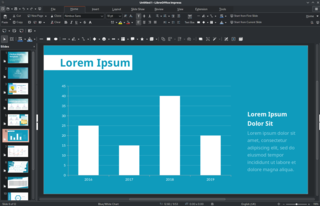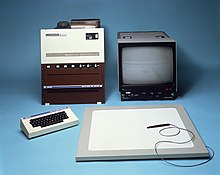
Amiga is a family of personal computers introduced by Commodore in 1985. The original model is one of a number of mid-1980s computers with 16- or 16/32-bit processors, 256 KB or more of RAM, mouse-based GUIs, and significantly improved graphics and audio compared to previous 8-bit systems. These systems include the Atari ST—released earlier the same year—as well as the Macintosh and Acorn Archimedes. Based on the Motorola 68000 microprocessor, the Amiga differs from its contemporaries through the inclusion of custom hardware to accelerate graphics and sound, including sprites and a blitter, and a pre-emptive multitasking operating system called AmigaOS.

Silicon Graphics, Inc. was an American high-performance computing manufacturer, producing computer hardware and software. Founded in Mountain View, California in November 1981 by James Clark, its initial market was 3D graphics computer workstations, but its products, strategies and market positions developed significantly over time.

A workstation is a special computer designed for technical or scientific applications. Intended primarily to be used by a single user, they are commonly connected to a local area network and run multi-user operating systems. The term workstation has been used loosely to refer to everything from a mainframe computer terminal to a PC connected to a network, but the most common form refers to the class of hardware offered by several current and defunct companies such as Sun Microsystems, Silicon Graphics, Apollo Computer, DEC, HP, NeXT, and IBM which powered the 3D computer graphics revolution of the late 1990s.

A graphics tablet is a computer input device that enables a user to hand-draw images, animations and graphics, with a special pen-like stylus, similar to the way a person draws images with a pencil and paper. These tablets may also be used to capture data or handwritten signatures. It can also be used to trace an image from a piece of paper that is taped or otherwise secured to the tablet surface. Capturing data in this way, by tracing or entering the corners of linear polylines or shapes, is called digitizing.

A framebuffer is a portion of random-access memory (RAM) containing a bitmap that drives a video display. It is a memory buffer containing data representing all the pixels in a complete video frame. Modern video cards contain framebuffer circuitry in their cores. This circuitry converts an in-memory bitmap into a video signal that can be displayed on a computer monitor.
The hacker culture is a subculture of individuals who enjoy—often in collective effort—the intellectual challenge of creatively overcoming the limitations of software systems or electronic hardware, to achieve novel and clever outcomes. The act of engaging in activities in a spirit of playfulness and exploration is termed hacking. However, the defining characteristic of a hacker is not the activities performed themselves, but how it is done and whether it is exciting and meaningful. Activities of playful cleverness can be said to have "hack value" and therefore the term "hacks" came about, with early examples including pranks at MIT done by students to demonstrate their technical aptitude and cleverness. The hacker culture originally emerged in academia in the 1960s around the Massachusetts Institute of Technology (MIT)'s Tech Model Railroad Club (TMRC) and MIT Artificial Intelligence Laboratory. Hacking originally involved entering restricted areas in a clever way without causing any major damage. Some famous hacks at the Massachusetts Institute of Technology were placing of a campus police cruiser on the roof of the Great Dome and converting the Great Dome into R2-D2.
Video editing is the post-production and arrangement of video shots. To showcase perfect video editing to the public, video editors must be reasonable and ensure they have a superior understanding of film, television, and other sorts of videography. Video editing structures and presents all video information, including films and television shows, video advertisements and video essays. Video editing has been dramatically democratized in recent years by editing software available for personal computers. Editing video can be difficult and tedious, so several technologies have been produced to aid people in this task. Overall, video editing has a wide variety of styles and applications.

In computing, a presentation program is a software package used to display information in the form of a slide show. It has three major functions:

Computervision, Inc. (CV) was an early pioneer in Computer Aided Design and Manufacturing (CAD/CAM). Computervision was founded in 1969 by Marty Allen and Philippe Villers, and headquartered in Bedford, Massachusetts, United States. Its early products were built on a Data General Nova platform. Starting around 1975, Computervision built its own "CGP" Nova-compatible 16-bit computers with added instructions optimized for graphics applications and using its own operating system known as Computervision Graphic Operating System (CGOS). In the 1980s, Computervision rewrote their code to operate on Unix-based platforms.

The Pixar Image Computer is a graphics computer originally developed by the Graphics Group, the computer division of Lucasfilm, which was later renamed Pixar. Aimed at commercial and scientific high-end visualization markets, such as medicine, geophysics and meteorology, the original machine was advanced for its time, but sold poorly.
The Cineon System was one of the first computer based digital film systems, created by Kodak in the early 1990s. It was an integrated suite of components consisting a Motion picture film scanner, a film recorder and workstation hardware with software for compositing, visual effects, image restoration and color management.
Quantel was a company based in the United Kingdom and founded in 1973 that designed and manufactured digital production equipment for the broadcast television, video production and motion picture industries. It was headquartered in Newbury, Berkshire. The name Quantel came from Quantised Television, in reference to the process of converting a television picture into a digital signal.
QFX is an image editing computer program developed by Ron Scott, a Texan photographer and software engineer. The first version was released in 1990. At the time of its release, QFX was one of the most feature-rich image editing applications available on the PC platform. It was the software of choice for digital artists and image postproduction studios in the times when 1024x768 truecolor graphics were a luxury, far before Photoshop could have been considered a serious professional tool. Its clean interface and clever workflow helped build a devoted user base, some of whom continue using it, despite QFXs being long ago eclipsed in features and users by Photoshop.

Motion graphics are pieces of animation or digital footage which create the illusion of motion or rotation, and are usually combined with audio for use in multimedia projects. Motion graphics are usually displayed via electronic media technology, but may also be displayed via manual powered technology. The term distinguishes static graphics from those with a transforming appearance over time, without over-specifying the form. While any form of experimental or abstract animation can be called motion graphics, the term typically more explicitly refers to the commercial application of animation and effects to video, film, TV, and interactive applications.

The Computer Originated World (COW) was the method of creating the BBC1 symbol that was used between 18 February 1985 and 16 February 1991. It was later used by the international, commercial television service BBC World Service Television from its launch until 26 January 1995.

Barco Creator was an image manipulation program targeted at the repro and print shop markets. It was developed by Barco Creative Systems a division of the Barco Group and first shown as a prototype at Parigraph in April 1988, then later at Ipex 88). Barco Creative Systems together with D.I.S.C. and Aesthedes merged into Barco Graphics. It ran on several generations of Silicon Graphics computers till the late 1990s. Barco Graphics ColorTone for Windows NT is considered its successor.

Computer graphics deals with generating images and art with the aid of computers. Today, computer graphics is a core technology in digital photography, film, video games, digital art, cell phone and computer displays, and many specialized applications. A great deal of specialized hardware and software has been developed, with the displays of most devices being driven by computer graphics hardware. It is a vast and recently developed area of computer science. The phrase was coined in 1960 by computer graphics researchers Verne Hudson and William Fetter of Boeing. It is often abbreviated as CG, or typically in the context of film as computer generated imagery (CGI). The non-artistic aspects of computer graphics are the subject of computer science research.
The history of computer animation began as early as the 1940s and 1950s, when people began to experiment with computer graphics – most notably by John Whitney. It was only by the early 1960s when digital computers had become widely established, that new avenues for innovative computer graphics blossomed. Initially, uses were mainly for scientific, engineering and other research purposes, but artistic experimentation began to make its appearance by the mid-1960s – most notably by Dr. Thomas Calvert. By the mid-1970s, many such efforts were beginning to enter into public media. Much computer graphics at this time involved 2-D imagery, though increasingly as computer power improved, efforts to achieve 3-D realism became the emphasis. By the late 1980s, photo-realistic 3-D was beginning to appear in film movies, and by mid-1990s had developed to the point where 3-D animation could be used for entire feature film production.
Adrian Wilson is a British photographer based in New York.















